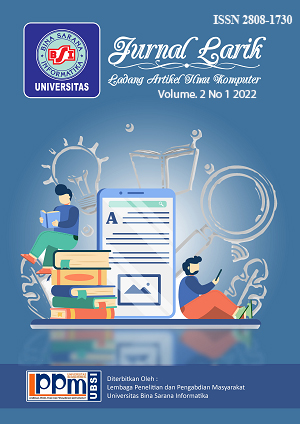Pencarian Criteria Splitting Terbaik Pada Algoritma C4.5 Untuk Mengukur Pemilihan Pembelajaran Pada Era Pendemi Covid-19
DOI:
https://doi.org/10.31294/larik.v2i1.1292Keywords:
Classification; C4.5; Splitting; Learning; Search.Abstract
The condition of the 2022 pandemic is still ongoing and has entered the 2nd year of the learning system that is still not 100% offline and is still being done online. The online learning system certainly makes parents, educators and students have to pay extra and extra understanding because not all of them can overcome these two things. Classification in determining the choice of learning becomes very important because online learning reaps the pros and cons in the community. In this study, the dataset was obtained from the results of a survey of parents, educators, students and students, and as many as 283 respondents had been collected to measure learning choices in the Covid-19 Pandemic Era. Data processing uses the Rapid miner application by applying the C4.5 Data Mining Classification Algorithm method, in the experimental process the split criteria comparison process is carried out on the C4.5 algorithm, namely Information Gain, Gini Index and Gain Ratio. The two highest accuracy values obtained are 85.88% for the Gain Ratio and Information Gain, while the Gini Index is 8.24%, for the AUC value the highest value is 0.80 in the Gain Ratio, followed by the Information Gain of 0.783 and the Gini Index of 0.784. Based on the comparison results, the Split gain ratio criterion is included in the Good classification category, because it has a value between 0.80 - 0.90.References
Y. Fitriani, S. Defit, and G. W. Nurcahyo, “Prediksi Hasil Belajar Siswa Secara Daring pada Masa Pandemi COVID-19 Menggunakan Metode C4.5,” J. Sistim Inf. dan Teknol., vol. 3, pp. 120–127, 2021, doi: 10.37034/jsisfotek.v3i3.54.
M. Huda et al., “DATA MINING EFEKTIVITAS PEMBELAJARAN DARING MENGGUNAKAN ALGORITMA K-MEANS,” vol. 1, no. 2, pp. 133–138, 2020.
D. Sartika and D. I. Sensuse, “Perbandingan Algoritma Klasifikasi Naive Bayes, Nearest Neighbour, dan Decision Tree pada Studi Kasus Pengambilan Keputusan Pemilihan Pola Pakaian,” J. Tek. Inform. Dan Sist. Inf., vol. 1, no. 2, pp. 151–161, 2017, [Online]. Available: https://doi.org/10.35957/jatisi.v3i2.78.
Yendrizal, Algoritma C4.5 pada Teknik Klsifikasi Penyusutan Pupuk, Cetakan Pe. Sumatera Barat: CV.Azka Pustaka, 2022.
R. Thabrani, Muhardi, and Faisal, “Analisa Kelayakan Pembelajaran Tatap Muka Sekolah Dimasa Pandemi Dengan Metode Naive Bayes,” pp. 11–15, 2021.
S. Lesmana et al., “Penerapan k-means dalam efektivitas pembelajaran e-learning pada masa pandemi covid-19,” Semin. Nas. Inform., vol. 2020, no. 1, pp. 100–110, 2020, [Online]. Available: http://www.jurnal.upnyk.ac.id/index.php/semnasif/article/view/4090.
A. Erfina, E. S. Basryah, A. Saepulrohman, and D. Lestari, “Analisis Sentimen Aplikasi Pembelajaran Online Di Play Store Pada Masa Pandemi Covid-19 Menggunakan Algoritma Support Vector Machine (Svm),” Semin. Nas. Inform., vol. 1, no. 1, pp. 145–152, 2020, [Online]. Available: http://jurnal.upnyk.ac.id/index.php/semnasif/article/view/4094.




